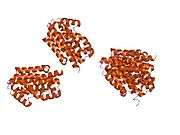HMOX1
HMOX1 (heme oxygenase (decycling) 1) is a human gene that encodes for the enzyme heme oxygenase 1 (EC 1.14.99.3). Heme oxygenase mediates the first step of heme catabolism, it cleaves heme to form biliverdin.
Heme oxygenase, an essential enzyme in heme catabolism, cleaves heme to form biliverdin, carbon monoxide, and ferrous iron.[5] The biliverdin is subsequently converted to bilirubin by biliverdin reductase. Heme oxygenase activity is induced by its substrate heme and by various nonheme substances. Heme oxygenase occurs as 2 isozymes, an inducible heme oxygenase-1 and a constitutive heme oxygenase-2. HMOX1 and HMOX2 belong to the heme oxygenase family.[6]
The HMOX gene is located on the long (q) arm of chromosome 22 at position 12.3, from base pair 34,101,636 to base pair 34,114,748.
Related conditions
- Heme oxygenase-1 deficiency
Anti-inflammatory effect
The ability of oxygenase 1 to catabolize free heme and produce carbon monoxide (CO) gives its anti-inflammatory properties by up-regulation of interleukin 10 (IL-10) and interleukin 1 receptor antagonist (IL-1RA) expression.[7]
See also
References
- 1 2 3 GRCh38: Ensembl release 89: ENSG00000100292 - Ensembl, May 2017
- 1 2 3 GRCm38: Ensembl release 89: ENSMUSG00000005413 - Ensembl, May 2017
- ↑ "Human PubMed Reference:".
- ↑ "Mouse PubMed Reference:".
- ↑ Lehninger's Principles of Biochemistry, 5th Edition. New York: W.H. Freeman and Company. 2008. p. 876. ISBN 978-0-7167-7108-1.
- ↑ "Entrez Gene: HMOX1 heme oxygenase (decycling) 1".
- ↑ Piantadosi CA, Withers CM, Bartz RR, MacGarvey NC, Fu P, Sweeney TE, Welty-Wolf KE, Suliman HB (May 2011). "Heme oxygenase-1 couples activation of mitochondrial biogenesis to anti-inflammatory cytokine expression". J. Biol. Chem. 286 (18): 16374–85. doi:10.1074/jbc.M110.207738. PMC 3091243. PMID 21454555.
Further reading
- Yachie A, Niida Y, Wada T, Igarashi N, Kaneda H, Toma T, Ohta K, Kasahara Y, Koizumi S (1999). "Oxidative stress causes enhanced endothelial cell injury in human heme oxygenase-1 deficiency". J Clin Invest. 103 (1): 129–35. doi:10.1172/JCI4165. PMC 407858. PMID 9884342.
- Zhang Z, Song Y, Zhang Z, Li D, Zhu H, Liang R, Gu Y, Pang Y, Qi J, Wu H, Wang J (2016). "Distinct role of heme oxygenase-1 in early- and late-stage intracerebral hemorrhage in 12-month-old mice". J Cereb Blood Flow Metab. doi:10.1177/0271678X16655814. PMID 27317654.
- Wang J, Doré S (2007). "Heme oxygenase-1 exacerbates early brain injury after intracerebral haemorrhage". Brain. 130 (6): 1643–52. doi:10.1093/brain/awm095. PMC 2291147. PMID 17525142.
- Soares MP, Brouard S, Smith RN, Bach FH (2002). "Heme oxygenase-1, a protective gene that prevents the rejection of transplanted organs". Immunol. Rev. 184: 275–85. doi:10.1034/j.1600-065x.2001.1840124.x. PMID 12086318.
- Morse D, Choi AM (2002). "Heme oxygenase-1: the "emerging molecule" has arrived". Am. J. Respir. Cell Mol. Biol. 27 (1): 8–16. doi:10.1165/ajrcmb.27.1.4862. PMID 12091240.
- Buelow R, Tullius SG, Volk HD (2002). "Protection of grafts by hemoxygenase-1 and its toxic product carbon monoxide". Am. J. Transplant. 1 (4): 313–5. doi:10.1034/j.1600-6143.2001.10404.x. PMID 12099373.
- Ishikawa K (2003). "Heme oxygenase-1 against vascular insufficiency: roles of atherosclerotic disorders". Curr. Pharm. Des. 9 (30): 2489–97. doi:10.2174/1381612033453767. PMID 14529548.
- Exner M, Minar E, Wagner O, Schillinger M (2005). "The role of heme oxygenase-1 promoter polymorphisms in human disease". Free Radic. Biol. Med. 37 (8): 1097–104. doi:10.1016/j.freeradbiomed.2004.07.008. PMID 15451051.
- Ozono R (2006). "New biotechnological methods to reduce oxidative stress in the cardiovascular system: focusing on the Bach1/heme oxygenase-1 pathway". Current Pharmaceutical Biotechnology. 7 (2): 87–93. doi:10.2174/138920106776597630. PMID 16724942.
- Tracz MJ, Alam J, Nath KA (2007). "Physiology and pathophysiology of heme: implications for kidney disease". J. Am. Soc. Nephrol. 18 (2): 414–20. doi:10.1681/ASN.2006080894. PMID 17229906.
- Chang CF, Cho S, Wang J (2014). "(-)-Epicatechin protects hemorrhagic brain via synergistic Nrf2 pathways". Ann Clin Transl Neurol. 1 (4): 258–271. doi:10.1002/acn3.54. PMC 3984761. PMID 24741667.
- Hill-Kapturczak N, Agarwal A (2007). "Haem oxygenase-1--a culprit in vascular and renal damage?". Nephrol. Dial. Transplant. 22 (6): 1495–9. doi:10.1093/ndt/gfm093. PMID 17389623.
























